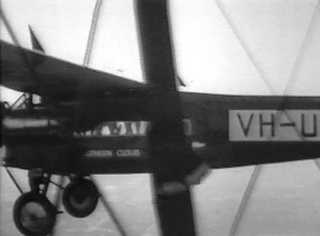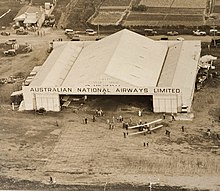
Sir Charles Edward Kingsford Smith, nicknamed Smithy, was an Australian aviation pioneer. He piloted the first transpacific flight and the first flight between Australia and New Zealand.

Sydney Kingsford Smith Airport — colloquially Mascot Airport, Kingsford Smith Airport, or Sydney Airport — is an international airport serving Sydney, New South Wales, Australia, located 8 km (5.0 mi) south of the Sydney central business district, in the suburb of Mascot. It is the primary airport serving Sydney and is a primary hub for Qantas, as well as a secondary hub for Virgin Australia and Jetstar, and a focus city for Rex Airlines.

Ansett Australia was a major Australian airline group, based in Melbourne, Victoria. The airline flew domestically within Australia and from the 1990s to destinations in Asia. After operating for 65 years, the airline was placed into administration in 2001 following a financial collapse and subsequent organised liquidation in 2002, subject to deed of company arrangement. The last flight touched down on 5 March 2002.
This is a list of aviation-related events from 1934:

The Avro 618 Ten or X was a passenger transport aircraft of the 1930s. It was a licensed version by Avro of the Fokker F.VIIB/3m.

The Southern Cross is a Fokker F.VIIb/3m trimotor monoplane that was flown by Australian aviator Charles Kingsford Smith, Charles Ulm, Harry Lyon and James Warner in the first-ever trans-Pacific flight to Australia from the mainland United States, a distance of about 11,670 kilometres (7,250 mi), in 1928.

Australian National Airways (ANA) was Australia's predominant aerial carrier from the mid-1930s to the early 1950s.

Desoutter is a British monoplane liaison aircraft manufactured by Desoutter Aircraft Company at Croydon Aerodrome, Surrey.

The de Havilland DH.61 Giant Moth was a 1920s British large single-engined biplane transport built by de Havilland at Stag Lane Aerodrome, Edgware. Intended primarily for use in Australia, a number were also shipped to Canada.

Sir Patrick Gordon Taylor,, commonly known as Bill Taylor, was an Australian aviator and author. He was born in Mosman, Sydney, and died in Honolulu.

The de Havilland DH.66 Hercules was a British 1920s seven-passenger, trimotor airliner built by de Havilland Aircraft Company. With the Hercules, Imperial Airways took over responsibility for the airmail service from the Royal Air Force, which had been operating the obsolete Airco DH.10 Amiens.

The Avro Avian is a series of British light aircraft designed and built by Avro in the 1920s and 1930s. While the various versions of the Avian were sound aircraft, they were comprehensively outsold by the de Havilland Moth and its descendants.
The Oswald Watt Gold Medal is an Australian aviation award named for Oswald Watt (1878–1921), a decorated pilot in World War I.

Charles Thomas Philippe Ulm was a pioneer Australian aviator. He partnered with Charles Kingsford Smith in achieving a number of aviation firsts, serving as Kingsford Smith's co-pilot on the first transpacific flight and the first flight between Australia and New Zealand. He and two others disappeared near Hawaii in 1934 while undertaking a test flight for an air service between Australia and the United States.
Keith Allison Virtue MBE was a pioneer Australian aviator. Sir Lawrence Wackett, in the foreword of Keith Virtue's biography, writes that he was an experienced airman himself but he marvelled at the ability and skill of Keith Virtue and counts him as one of the greatest of the Australians who devoted their life's work to the task of pioneering airlines in Australia.

The Southern Cloud, registered VH-UMF, was one of five Avro 618 Ten three-engined aircraft flying daily airline services between Australian cities for Australian National Airways in the early 1930s.

Albert Aubrey (Aub) Koch, MBE was a pioneering Australian military and civil pilot. He trained at Point Cook in 1926, and following graduation accepted a Short Service Commission in the Royal Air Force (RAF) as there were no places available in the Royal Australian Air Force (RAAF) at the time. After four years service in Egypt and Palestine, he returned to Australia and was commissioned into the Citizen Air Force, flying with No. 1 Squadron at Laverton, where he gained flying instructor qualifications. Soon afterwards, he was employed by Guinea Airways as an aircraft captain, and spent five years in Papua and New Guinea (PNG), gaining fame as the rescuer of the Archbold expedition. Koch was transferred to the RAAF Active Reserve upon going to PNG. He joined Qantas a year before World War II broke out, employed predominantly on the Singapore route. He was unfortunate to be the captain of the only Qantas aircraft known to be shot down during that war, when the Short Empire flying boat Corio was lost off Timor. Post war he was recruited by Lester Brain at the formation of Trans Australia Airlines (TAA), specifically to be Senior Pilot DC4 Skymaster. At 45, he retired from active flying to become Inspector of Safety and Accidents, TAA.
Harry Frank "Jim" Broadbent was a British pilot largely raised in Australia, who took part in air racing and record-breaking flights in the 1930s.
Hart Aircraft Service Pty. Ltd. was an Australian aviation company registered at Melbourne in mid-1929 with directors James Hart, John Hider and Norman Charles Trescowthick. Director James Hart (c1891-1951) was a former Royal Flying Corp aviator who had flown as gunner for Hereward de Havilland. Norman Trescowthick had served with distinction in the Australian Flying Corps' famous 4th Squadron with Arthur H. Cobby during the First World War.

George Henry "Harry" Purvis, AFC was an Australian pioneer aviator, engineer, airline pilot, air-force pilot and author. He was the engineer responsible for maintenance of the famed Southern Cross aircraft. Purvis often flew as co-pilot with Sir Charles Kingsford Smith and was the last person to fly the Southern Cross. Purvis was co-pilot to P. G. Taylor on the first flight across the lower Pacific Ocean from Australia to South America, landing in Chile in 1951.
















